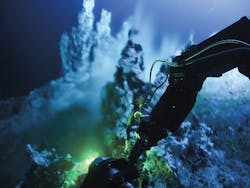Future deep-sea UUVs with machine autonomy are focus of DARPA Angler program
ARLINGTON, Va. — U.S. Military researchers are asking the defense industry to develop a deep-diving unmanned underwater vehicle (UUV) and control system able to find and manipulate objects in deep-sea environments.
Officials of the U.S. Defense Advanced Research Projects Agency (DARPA) have issued a broad agency announcement (HR001119S0009) for the Angler project (not an acronym) for new capabilities in autonomous exploration and manipulation on the sea floor.
The deep ocean remains one of the most challenging earth-bound domains, despite breakthroughs in terrestrial robotics, space robotics, and underwater sensing, DARPA scientists explain.
While the sea floor often is gently sloping sand dunes, it also has natural and man-made obstacles that complicate search and navigation. Reefs, submarine vents, and fissures can be treacherous, and can change quickly. This represents a major challenge to classical machine perception techniques, which rely on feature recognition.
Deep-sea missions also require continuous operation over thousands of miles without the aid of Global Positioning System (GPS) satellite navigation or human intervention, which imposes substantial autonomy requirements on an already complex system.
The DARPA Angler project has two thrusts. First it seeks to develop an autonomous undersea control system that processes mission commands and sensor inputs, understands the sea bed, and provides control inputs to unmanned vehicles to pick up and move objectives on the sea floor.
Machine autonomy seeks to overcome the terrain and tactical challenges of the deep-sea ocean floor.
Second, the project seeks to design an underwater robot to navigate the sea floor and physically manipulate objects in deep-sea environments.
Manipulating objects underwater can be more difficult than it sounds. Murky sea water, for example, can complicate perception, search, object recognition, and estimation. Man-made objects also may be deteriorated, slippery, or partially covered.
With these conditions in mind, deep-sea teleoperation is difficult enough; It can be next-to-impossible with vision systems and machine autonomy mixed-in.
Underwater manipulation today typically happens with remotely operated vehicles (ROVs) tethered to a surface vessel, and tele-operated by a human pilot. This can limit their utility because ROVs cannot extend beyond their tethers, and need several operators.
Wireless communications for sub-sea teleoperations, moreover, largely is impractical because seawater attenuates electromagnetic wave propagation and available bandwidth.
Instead, DARPA researchers want industry to develop the Angler robotic system capable of long-distance underwater manipulation missions. It will operate autonomously and without external communication to navigate, search, localize, and physically manipulate objects on or near the sea bed; onboard sensors will self-localize, avoid obstacles, interact with the sea bed, and manipulate objects. It also will search for and manipulate deep undersea objects in dark or murky water.
Chief enabling technologies for this project will involve manipulation and autonomy in underwater robotics, DARPA researchers say. Eventually these technologies may move to an operational military system.
DARPA researchers expect the Angler program to capitalize on land-, space-, and floating-base robotics, terrestrial autonomous manipulation, and underwater sensing for long-distance missions on the sea bed.
The program aims to discover autonomous robotic solutions in sensing techniques for high-resolution navigation in GPS-deprived underwater environments; perception and manipulation for grasping degraded and malformed manmade objects; long-duration autonomy; and mission planning without human intervention.
Angler will fit an underwater robot with autonomy and control technologies for one long mission without human intervention. Proposers should focus on autonomy and decision support algorithms to identify and grasp challenging objects.
DARPA scientists want proposers to capitalize on existing hardware, software, simulation infrastructure, and physical interfaces as much as possible.
Capabilities of interest include long-duration machine autonomy; information fusion; object recognition; autonomous grasp planning; dynamic station keeping at or near the sea bed; and sustained sprint capabilities to evade obstacles and traffic.
DARPA will choose several contractors to work on separate aspects of the Angler program. Companies interested should submit abstracts no later than 30 Jan. 2019, and proposals no later than 23 March 2019, to the DARPA BAA Website at https://baa.darpa.mil. Email questions or concerns to DARPA at [email protected].
More information is online at https://www.fbo.gov/spg/ODA/DARPA/CMO/HR001119S0009/listing.html.

